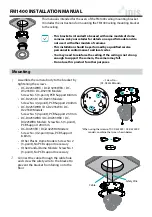
i
Safety Precautions
GENERAL PRACTICES
1.
ALWAYS WEAR GOGGLES OR SAFETY
GLASSES. Refrigerant liquid and battery acid can per-
manently damage the eyes (see First Aid under Refrig-
eration Oil).
2.
Never operate the unit with the compressor discharge
valve closed.
3.
Keep your hands clear of the fans and belts when the
unit is running. This should also be considered when
opening and closing the compressor service valves.
4.
Make sure the gauge manifold hoses are in good condi-
tion. Never let them come in contact with a belt, fan
motor pulley, or any hot surface.
5.
Never apply heat to a sealed refrigeration system or
container.
6.
Fluorocarbon refrigerants, in the presence of an open
flame or electrical short, produce toxic gases that are
severe respiratory irritants capable of causing death.
7.
Make sure all mounting bolts are tight and are the cor-
rect length for their particular application.
8.
Use extreme caution when drilling holes in the unit.
The holes may weaken structural components. Holes
drilled into electrical wiring can cause fire or explosion.
9.
Use caution when working around exposed coil fins.
The fins can cause painful lacerations.
10. Use caution when working with a refrigerant or refrig-
eration system in any enclosed or confined area with a
limited air supply (for example, a bus or garage).
Refrigerant tends to displace air and can cause oxygen
depletion, resulting in suffocation.
11. EPA Section 608 Certification is needed to work on
refrigeration systems.
REFRIGERANT
Although fluorocarbon refrigerants are classified as safe
refrigerants, certain precautions must be observed when
handling them or servicing a unit in which they are used.
When exposed to the atmosphere in the liquid state, fluoro-
carbon refrigerants evaporate rapidly, freezing anything
they contact.
First Aid
In the event of frost bite, the objectives of First Aid are to
protect the frozen area from further injury, to warm the
affected area rapidly, and to maintain respiration.
•
EYES: For contact with liquid, immediately flush eyes
with large amounts of water and get prompt medical
attention.
•
SKIN: Flush area with large amounts of lukewarm
water. Do not apply heat. Remove contaminated cloth-
ing and shoes. Wrap burns with dry, sterile, bulky
dressing to protect from infection/injury. Get medical
attention. Wash contaminated clothing before reuse.
•
INHALATION: Move victim to fresh air and use CPR
or mouth-to-mouth ventilation, if necessary. Stay with
victim until arrival of emergency medical personnel.
REFRIGERANT OIL
Avoid refrigeration oil contact with the eyes. Avoid pro-
longed or repeated contact of refrigeration oil with skin or
clothing. Wash thoroughly after handling refrigeration oil to
prevent irritation.
First Aid
In case of eye contact, immediately flush with plenty of
water for at least 15 minutes. CALL A PHYSICIAN. Wash
skin with soap and water.
Summary of Contents for SB-III 30 SR+
Page 4: ......
Page 8: ......
Page 10: ...ii ...
Page 14: ...4 ...
Page 24: ...Unit Description Rev 04 02 14 Unit Photos Front View AGA231 ...
Page 28: ...18 ...
Page 66: ...56 ...
Page 98: ...88 ...
Page 110: ...100 ...
Page 111: ...101 Early Model Coiled Wire Fuse Link Wiring Schematic ...
Page 112: ...102 Early Model Coiled Wire Fuse Link Wiring Diagram Page 1 of 4 ...
Page 113: ...103 Early Model Coiled Wire Fuse Link Wiring Diagram Page 2 of 4 ...
Page 114: ...104 Early Model Coiled Wire Fuse Link Wiring Diagram Page 3 of 4 ...
Page 115: ...105 Early Model Coiled Wire Fuse Link Wiring Diagram Page 4 of 4 ...
Page 116: ...106 Late Model Fuse Link in Battery Cable Wiring Schematic ...
Page 117: ...107 Late Model Fuse Link in Battery Cable Wiring Diagram Page 1 of 4 ...
Page 118: ...108 Late Model Fuse Link in Battery Cable Wiring Diagram Page 2 of 4 ...
Page 119: ...109 Late Model Fuse Link in Battery Cable Wiring Diagram Page 3 of 4 ...
Page 120: ...110 Late Model Fuse Link in Battery Cable Wiring Diagram Page 4 of 4 ...










































